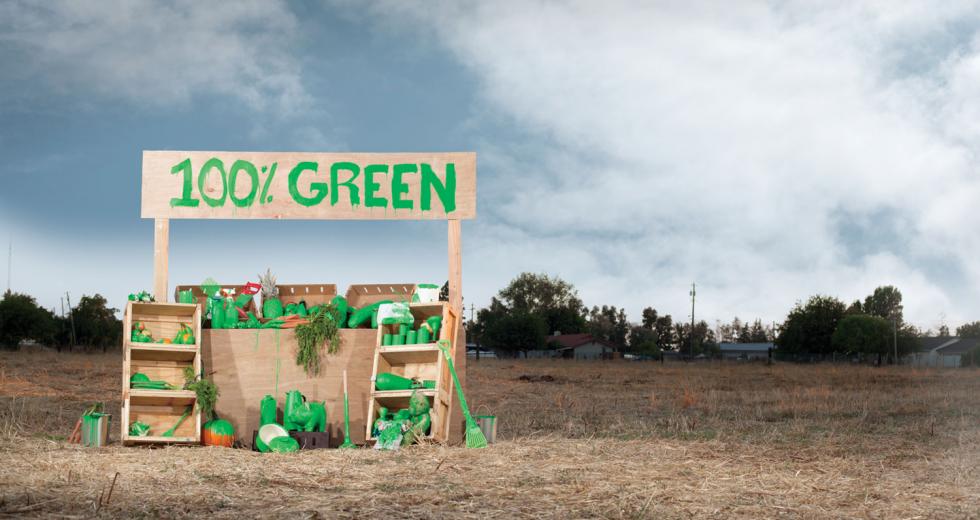As consumers fill their lives with reusable shopping bags, organic foods and energy-efficient vehicles, touting the environmental friendliness of goods and services has become an increasingly important marketing strategy for companies worldwide. This, coupled with vague government guidelines for green marketing claims, is causing challenges as competitors, consumers and environmental advocates demand standards and verification of these claims.
“If you’re sued for falsely making green claims about your product, the negative publicity can be really, really damaging,” says Jeff Galvin, a partner at Downey Brand LLP in Sacramento. “It’s not just the short-term issues of ‘Am I liable, how much am I going to have to pay and how much is it going to cost me to defend this?’ but rather what’s the public relations damage associated with this? Most law enforcement agencies don’t do private or confidential settlements. If they settle with you, it’s going to be publicly reported.”
The Federal Trade Commission is expected to crack down on greenwashing — misleading consumers about the environmental practices of a company or the environmental benefits of a product or service — when it updates its guidelines later this year or early in 2011 for the first time in more than a decade.
The FTC’s two-year process to revise its “Guides for the Use of Environmental Marketing Claims” is wrapping up now. As part of its review, the Commission held a series of public meetings to discuss green marketing issues, including those related to carbon offsets, renewable energy certificates and green packaging claims about textiles, building products and buildings. Feedback from those meetings would likely be disclosed around November.
“We moved the review of the Green Guides up a year because we saw that more of these claims were being made, and since that time we have brought several claims forward regarding recyclables, compostables and textiles,” says FTC spokesperson Mitchell Katz.
The FTC’s guidelines so far have applied to environmental claims included in labeling, advertising and promotional materials. However, these are guidelines and not laws, so they aren’t enforceable.
“There’s really sort of a patchwork of standards,” Galvin says. “It takes awhile for standards to develop, so businesses might use terminology to reference the green-friendly aspects of products or service without there really being any kind of benchmark of what a certain kind of claim needs.”
For example, if you claim to be selling a product that is biodegradable, what does that mean? Does it mean it’s gone in a year? A thousand years?
The FTC has identified 78 retailers selling clothes or other textiles labeled and advertised as made from bamboo when they actually contain manufactured rayon fiber.
This lack of specificity is nothing new. Back in the 1980s and ’90s, when recycled paper hit the mainstream, consumers were shocked to learn how little post-consumer waste their “recycled” paper actually contained, says Lila Wallrich, the creative director at Wallrich Landi Integrated Marketing Communications in Sacramento.
The same can be said for the low-fat foods craze of the ’90s in which consumers embraced low-fat foods for heart disease prevention and weight loss. The low-fat approach became an overarching ideology, promoted by physicians, the federal government and the food industry. Meanwhile, according to a report published in the Oxford Journal of the History of Medicine and Allied Sciences, Americans just kept getting fatter as the industry began replacing fat with sugar in processed foods, “leading to what would by the 1990s become known as the ‘Snackwell’s phenomenon,’ low-fat foods harboring just as many calories as the former high-fat versions.”
As for greenwashing, most claims have originated in California, according to the FTC. In January a state appellate court gave a San Diego man the go-ahead to proceed with a lawsuit against American Honda Motor Co. in which he claims his Civic Hybrid uses too much gas to be considered fuel-efficient.
In March a California consumer filed a federal class action suit against S.C. Johnson & Son Inc. alleging the company is misleading consumers about the “environmental safety and soundness” of Windex because, while the bottle is stamped with S.C. Johnson’s Greenlist trademark, the claim is not verified by a third party.
“Marketers realized that consumers would be more susceptible to environmental claims, and that’s about the time we saw this big shift toward green claims, sustainable claims, recyclable [and] biodegradable,” Katz says. The FTC established its Green Guides in 1992 and has updated them twice since, but there are also new types of green claims, such as those that relate to carbon offsets, which weren’t around during the 1998 revision.
“There is certainly growing knowledge that being environmentally friendly may be perceived as a benefit in some markets,” Wallrich says. “I’ve found the green marketing guidelines offered by the Federal Trade Commission to be comprehensive and easy to understand. They basically follow common sense: You can’t make a claim that misleads a reasonable consumer.”
Debi Hammond, the president and CEO of Merlot Marketing Inc. in Sacramento, works with a number of clients in the home products category. To avoid risk in the marketplace and target a company’s message, she has steered her clients away from making big claims about sustainability and being green.
“The industry has gotten itself into a bit of trouble,” she says. “Everyone was claiming everything to be green, so we steer our clients to be more responsible in the ways they market. Consumers are looking for more than hype. We don’t spend a lot of time crafting hyperbole. We just make sure the client is doing what they can from a sustainability standpoint, and then we talk about that.”
“We don’t spend a lot of time crafting hyperbole. We just make sure the client is doing what they can from a sustainability standpoint, and then we talk about that.”
Debi Hammond, president and CEO, Merlot Marketing Inc.
She points to client BR-111, a manufacturer of hardwood floors from Brazilian forests. BR-111, for example, is certified by the Forest Stewardship Council for environmental responsibility, social benefits and economic viability. So rather than focus on nebulous buzzwords such as sustainable and eco-friendly, BR-111’s marketing materials call attention to these measurable accolades.
“We drill down to the essence of the green element of the product and how we can own that in the consumer’s mind,” says Julie Fraga, the account representative working on BR-111’s ad campaign at Merlot Marketing.
That might seem logical enough, but according to a recent study by TerraChoice, an Ottawa-based environmental marketing agency, the vast majority of products claiming to be green overstate their environmental sustainability. The TerraChoice study found that the number of green products on the market has increased by 79 percent from 2007 to 2009, and 98 percent of them made exaggerated or misleading claims. TerraChoice’s researchers surveyed 2,200 so-called green products on sale at big-box retailers in the U.S. and Canada by testing the claims found on the products against best practices, notably against guidelines provided by the FTC and Canada’s Competition Bureau.
Likewise, the FTC has identified 78 retailers, including Target, Macy’s, Lands’ End and Bloomingdale’s, that were selling clothing or other textiles labeled and advertised as made from bamboo when they actually contained manufactured rayon fiber. These companies received letters notifying them that they “may be breaking the law.” Rayon is a man-made fiber created from the cellulose found in plants and is processed with chemicals that release air pollution. Any plant or tree — including bamboo — could be used as the cellulose source, but the fiber created is rayon.
The U.S. and Canada aren’t the only nations looking to reign in green claims. The United Kingdom’s Department for Environment Food and Rural Affairs recently updated its Green Claims Code, and requirements for self-declared green claims are now being enforced in Norway, Australia and France.
Overstating the environmental benefits of a product can water down its value because consumers could grow callous to exaggerated claims. To prevent this from happening, Wallrich and Galvin encourage clients to talk with their attorney and ad agency at length about what they want to promote, what expressed and implied claims they want to make and what proof they have to support those claims.
The executives at OMI Organic Mattresses Inc. can attest to that. The Yuba City-based manufacturer is the largest producer of organic bedding in America, building up to 100 mattresses daily.
“If you can’t stand by what you’re saying in 36-point font, you probably should change what you’re saying.”
Jeff Galvin, partner, Downey Brand LLP
“We are an organic company, but we don’t say we sell a certified organic mattress because the [United States Department of Agriculture] doesn’t certify organic mattresses,” says President and CEO Walt Bader. “It is organic by the sum of its parts.”
The sum of OMI’s parts can be broken down to include a nonsmoking staff that doesn’t wear fragrances or use chemical laundry detergents at home. They also use organic soap in the bathroom, chemical-free ink in the pens, certified organic cotton from Texas, certified organic wool from Napa, certified organic thread, rubber, wood and adhesives; and even the compressed air used to clean the final product is sterilized to prevent exposure to external airborne pollutants. Trash bins are hard to come by in the facility because every ounce of material is used.
“What we sell is purity,” Bader says. “We state individual certifications rather than broad descriptions, and we guarantee all the products: If you can find a purer mattress, we’ll give you ours free.”
Those certifications are renewed at least annually and are listed and explained prominently on the company’s marketing materials, which include a 14-point checklist consumers can use to compare OMI mattresses against others while shopping.
“You can’t come up with evidence later, and you can’t bury things in the fine print,” Galvin says. “If you can’t stand by what you’re saying in 36-point font, you probably should change what you’re saying. That’s as true with green marketing claims as it would be with any other issue, but I think given that there is a relative lack of standards in this area, and given the huge amount of advocacy and competitor interest in this area in terms of folks who are going to scrutinize your claims, the risk is increasingly high.”
— Andrea Lorenz contributed to this report.
Recommended For You

Totally Modular
Picking apart the pieces of modular construction
The construction site was nearly immaculate. There were no free-standing ladders, power cords were coiled neatly and only a stray nail, crushed cup and small pile of sawdust littered the floor. The 91,000-square-foot factory was full of skylights with chartreuse buttresses and turquoise shelving, creating a bright, showroom feel.

Sticker Shock
Pricing errors can result in traumatic losses. Here’s how to respond.
One morning last year, Cyberguys, a computer and tech accessories retailer, started getting a lot of calls from customers with the same question. Was the company really selling hard drives for $3?



